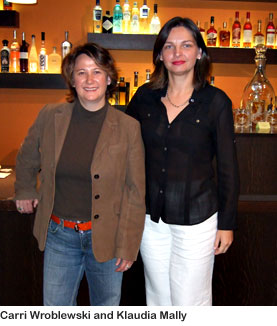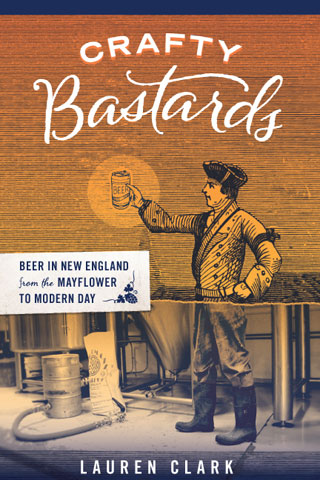September 20th, 2007

After I learned from my more with-it colleagues in drink that obscure cocktail ingredients could be found at BRIX Wine Shop in the South End, I ventured over there with notebook and camera in hand. I just had to interview Carri Wroblewski and Klaudia Mally, the two self-described “chix” who own the place, and find out what they were up to.
If you’re used to the typical Massachusetts package store with its motley hodgepodge of wines o’ the world and dusty bottles of Leroux cordials, you might walk into BRIX and think, ‘Ooops, wrong tax bracket!’ Each bottle here seems to occupy its own special place on the sleek shelves, the way individual sweaters are displayed in high-end clothing boutiques. But take a closer look, and you’ll find reasonably priced wines along the bottom shelves, just like in any other liquor store. Luckily, these wines have been certified Not To Suck by Wroblewski and Mally, who forsake the usual suspects in favor of offbeat stuff they truly like, culling their selection from 39(!) different distributors.
The ladies are industry veterans — Wroblewski worked for J. Lohr Wines and Frederick Wildman & Sons importers, Mally waited tables at Grill 23 before working in mergers and acquisitions for a software company — and they’re all about education and service. They hold weekly public tastings and offer private ones by invitation or appointment. And they network with influential people in the Boston bar industry to stay on top of in-demand but hard-to-find spirits like Luxardo Maraschino liqueur, Amer Picon, Van Winkle bourbon and Peychaud’s and orange bitters. If you can’t find some oddity necessary for an obscure cocktail, BRIX will do its best to special-order it for you.
If you, like me, are closer to downtown Boston than the South End, you’re in luck — Wroblewski and Mally are opening a new store on Broad Street in October. It will look similar to the four-year-old mothership, but it’ll have a private tasting room for events. If you want up-to-date info on tastings and special offers, get on the BRIX mailing list. Oh, in case you were wondering, “brix” is the name of a scale used in winemaking to measure the sugar content in grape juice.
Posted in Cocktails, Drinking supplies, Wine | 6 Comments »
September 14th, 2007

Calling all winos — have you been to Bin 26 Enoteca yet? I checked it out for the first time recently and, I have to say, “thumbs up.” This place has been open for, what, a year or something, and it has received tons of good press. Once I wrapped my head around the extensive wines-by-the-glass menu and realized that the prices were fair (especially for Beacon Hill), I leaned back in my cool seatbelt-weave chair and let our doll of a scruffy-haired waiter take over. He was the embodiment of Bin 26’s mission to replace wine appreciation’s tweed blazer with a Ben Sherman track jacket.
Some observations:
The 250 ml portion of “wine by the glass” equals over eight ounces and can easily be split by two people. Prices for 250 ml start at $11. You can also get portions of 100 ml, 500 ml (about two-thirds of a bottle) and 750 ml (a whole bottle).
The bathrooms are decorated with upside-down wine bottles (see photo).
The beef carpaccio with aged parmesan and arugula appetizer ($11) is tasty, and so are the risotto balls stuffed with pecorino cheese ($8).
I got the impression that the staff can both banter with the connoisseur and guide the uninitiated.
The Thunderbird and Night Train listed on the first page of the wine menu: refreshingly irreverent or trying too hard to be hip? You make the call.
An “enoteca” in Italy refers to “a place where one can find simple foods to accompany the wines served there,” according to Bin 26’s website.
Posted in Boston bars, Wine | 1 Comment »
September 8th, 2007
 Man, I have really dropped the ball. It has been over a year since I dissed vodka. It’s time, then, for part 3 of drinkboston’s Vodka R.I.P. series. In part 1, I talk about how the ubiquity of this colorless, flavorless spirit has dumbed-down mixology. In part 2, I investigate how this state of affairs came to be. Here, I present evidence that knocks vodka down a few more pegs.
Man, I have really dropped the ball. It has been over a year since I dissed vodka. It’s time, then, for part 3 of drinkboston’s Vodka R.I.P. series. In part 1, I talk about how the ubiquity of this colorless, flavorless spirit has dumbed-down mixology. In part 2, I investigate how this state of affairs came to be. Here, I present evidence that knocks vodka down a few more pegs.
I know, I know. You’re a bartender, and you’re saying, “I have to keep my customers happy! Vodka’s what they want to drink. If I put a bunch of gin and whiskey cocktails on my menu, people will freak. That stuff scares them.”
Here’s something that’ll scare them even more, or at least kill their buzz:
“Achieving the ‘purity’ so essential to the spirit is almost impossible on an artisanal pot still. Making pure ethanol is what industrial stills do best, which is why two of the … major players producing vodka in the U.S. are Archer-Daniels-Midland and Grain Processing Corp. of Muscatine, Iowa. ADM sells its 190-proof beverage alcohol (product code 020001) packaged one of three ways: ‘Bulk Truck, Bulk Rail, Tank.’ Cut it with water … bottle it, and you’re in the vodka business,” writes Eric Felten in the Wall Street Journal (“Make Mine a 020001,” 9/1/07).
Bulk Truck! That’s going to be the name of my new premium vodka. Does it get any more obvious that the path from America’s largest agricultural processor to a $40 bottle of Grey Goose is paved with marketing wiles and consumer gullibility? Bartenders, if a vodka-drinking customer remains unfazed by this fact and says, ‘Who cares? I like the smooth taste of Brand X,’ you might run another Felten tidbit by him:
“I went to a vodka tasting hosted by the head of a prominent luxury liquor house. After being walked through the vodkas on the table with elaborate descriptions of the characteristics of each, I found myself hard-pressed to discern much difference. So I asked the executive to demonstrate the differences by tasting the vodkas blind. He couldn’t even identify his own flagship brand.”
I’m not saying that some gins, rums, tequilas and other big-name “premium” spirits aren’t produced in industrial quantities. But they aren’t as dependent as vodka on high-falutin’ claims of purity and sophistication. They have distinguishable flavors that come from their base ingredient, i.e. sugar cane or agave, or from botanicals like juniper, or from barrel aging. Vodka doesn’t. Claims of purity and sophistication are all it has. And now that the vodka market is so crowded, marketers are trying to set their products apart by, for example, touting earth-friendly distillation methods and packaging (360 Vodka) or organic ingredients (Square One Organic Vodka).
One way that vodka makers have been trying to wring money out of the category for years now is through flavors. You know, vanilla, raspberry, orange (or “oranj” if you’re Stoli — ooh, such stylish spelling!), etc. I recently sat down with a PR woman for the Van Gogh vodka brand at the South End bar 28 Degrees. She gave me samples of several Van Gogh vodkas, including pineapple, acai-blueberry, chocolate and espresso. She wanted to know what I thought of them. I told her that the flavors were authentic enough — the pineapple tasted like pineapple, the espresso tasted like espresso — but that they were not at all interesting for someone like me, who actually enjoys the taste of spirits and seeks out drinks whose ingredients form an actual Cocktail, as opposed to something that merely mimics another food or beverage.
On occasion, people say to me something like, “So I have a pomegranate vodka martini and I enjoy it. So what? No one gets hurt.”
Right, no one gets hurt. Except for the people who are desperately seeking a drink that tastes like a drink and not like a dessert or a cup of coffee or a glass of fruit juice. And with a lot of vodka mixology, you’re lucky if you get even that. The one cocktail that I sampled at 28 Degrees, the Prosciutto and Melon, was not even as mildly pleasant as I thought it would be. I was imagining a drink that tasted like spiked fresh cantaloupe. Instead, the drink tasted strangely metallic. And the kicker was the garnish. The strip of prosciutto that was wrapped around the ball of melon left little beads of animal fat floating atop the puréed cantaloupe-melon vodka mixture. Ick. Is this really the sort of drink people want to pay $12 for?
Posted in Boston bars, Cocktails, Vodka | 20 Comments »


 Man, I have really dropped the ball. It has been over a year since I dissed vodka. It’s time, then, for part 3 of drinkboston’s Vodka R.I.P. series. In
Man, I have really dropped the ball. It has been over a year since I dissed vodka. It’s time, then, for part 3 of drinkboston’s Vodka R.I.P. series. In 